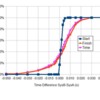Hi everyone.
I did an analysis recently which I think gets to the very heart of this topic of timing precisions. Last season I noticed that the difference between our SysA and SysB times were larger than I expected. So I examined the distribution of these differences for all of our races, and what I found surprised me:
1. ~50% of the run times differ by >= 0.01s (both positive and negative).
2. ~10% of the run times differ by >= 0.02s (both positive and negative).
3. Virtually all of the difference occurs at the finish, which is contrary to the study noted previously in this thread. 99% of the start TOD difference is <= 0.005s, and most start time differences are <= 0.002s.
4. The fact that the start TOD differences are so well behaved indicates that the timers are working well. They are not drifting relative to each other.
5. The finish TOD differences between the SysA and SysB vary randomly. The difference can go from +0.03s to -0.02s for consecutive racers.
Naturally, I was concerned that our club's results were atypical. I wanted to see another hill's results, and so I analyzed the race files for the March 2012 Men's Eastern Cup GS at Burke which I had from the TC1 test prep. Low and behold, the results were virtually identical: 55% of the A/B time difference were >= 0.01s, and 8% were >= 0.02s.
I spoke with David Iverson (BMA) about this, and he thought that the results are entirely reasonable. Like me, David suspected the cause of the difference was due to different parts of the body breaking the two beams at different times. Fred Patton has actually proven this with a high-speed photofinish study done at the 1999 Worlds at Vail.
So, if two completely legal timing systems give times which differ by more than +/- 0.01s 50% of the time, I would conclude that our timing precision is worse than 0.01s – maybe 0.02s or 0.03s, depending on how much variation you are willing to accept.
The problem, I believe, is the rather nebulous definition of what constitutes a finish:
[ACR 611.3.1] With electronic timing, the time is taken when the competitor crosses the finish line and triggers the beam between the photo cells.
What part of the competitor? The tip of the skis? The shins? A ski pole? And even if the ACR did more precisely define what constitutes a finish (for example, the shins breaking the PLANE between the finish posts), we have no way of reliably capturing that with our finish eyes. The only way to do that is with a photofinish system, which is prohibitively expensive.
The timing systems that we have are not bad. My only point is that there is really no sense in expending effort on improving the precision of the start gate or the timers before we find a way to more reliably and repeatably define and capture the finish.
You can view the analysis details for one of my typical races as well as for the Eastern Cup GS at the following link (I hope that this works ...):
https://onedrive.live.com/redi...BF9D2FF1FF3A5A%21140
